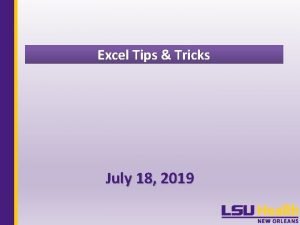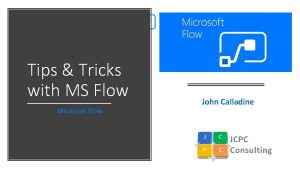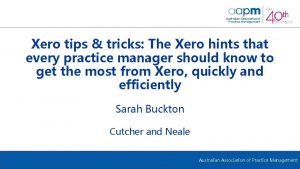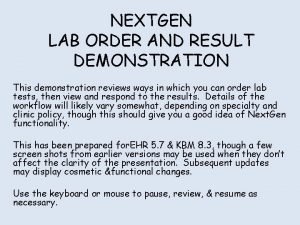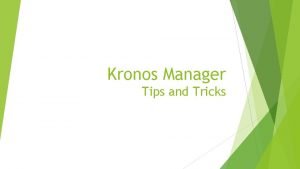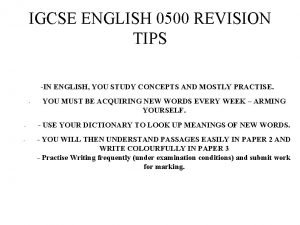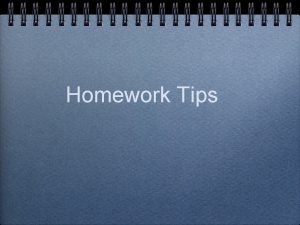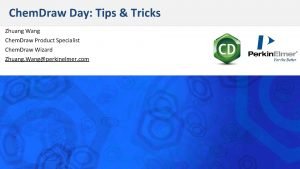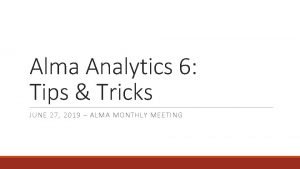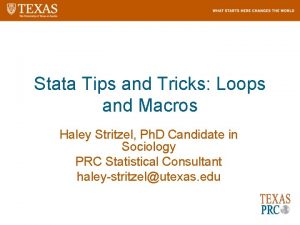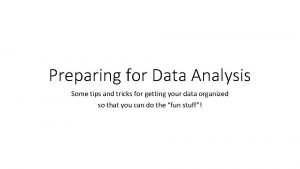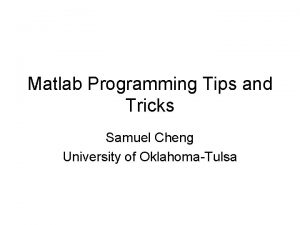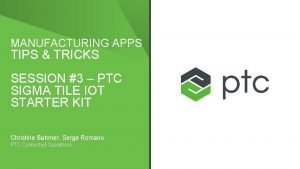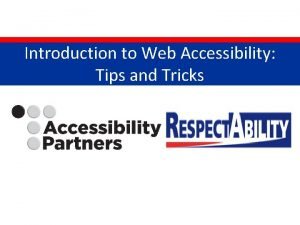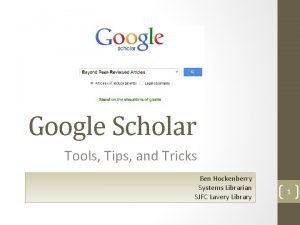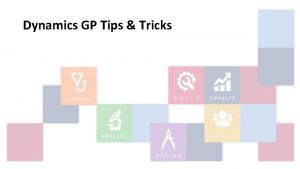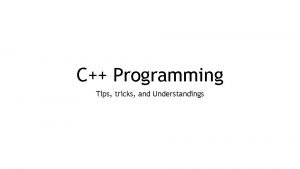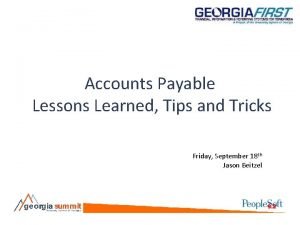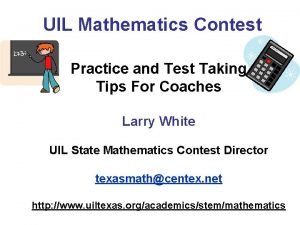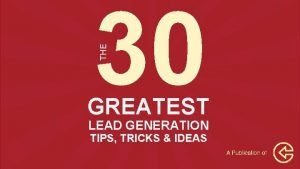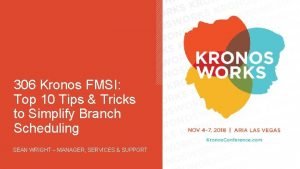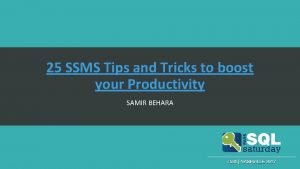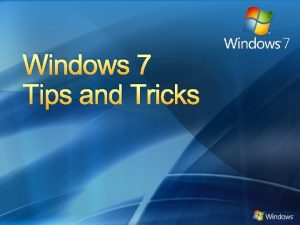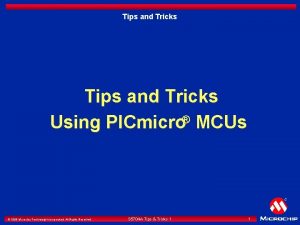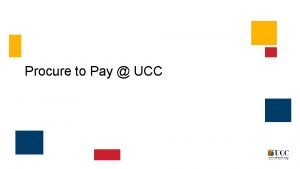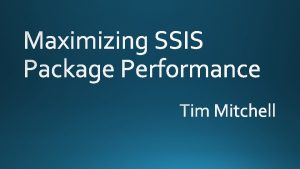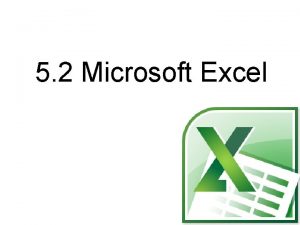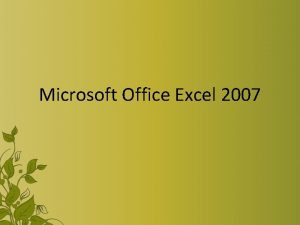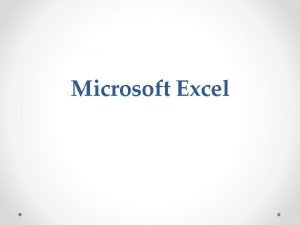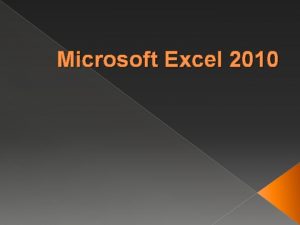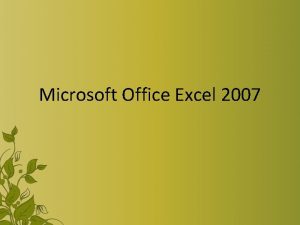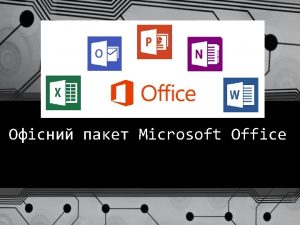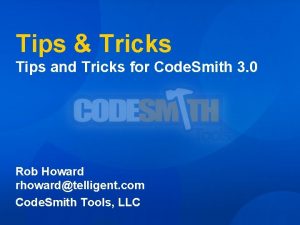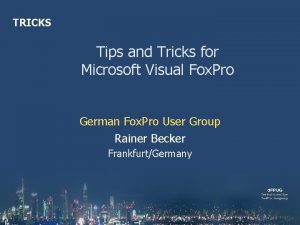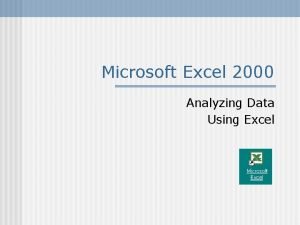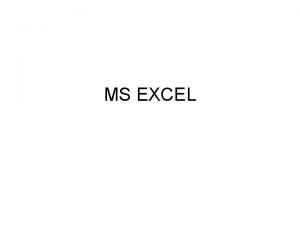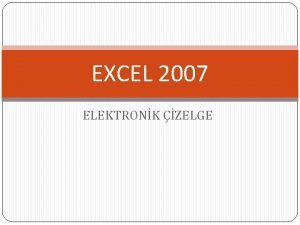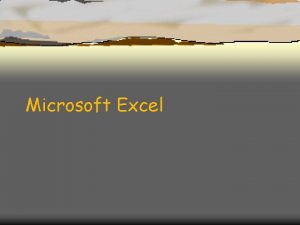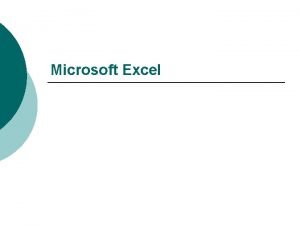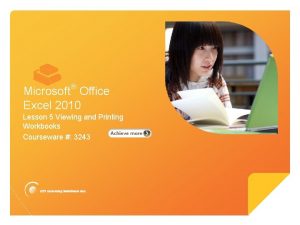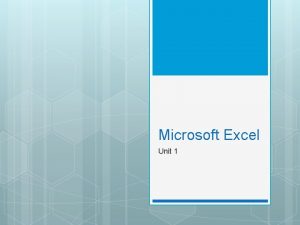Microsoft Excel Tips Tricks Laura Nelson Manager Support



































- Slides: 35

Microsoft Excel Tips & Tricks Laura Nelson Manager, Support & Quality Assurance

Quick Access Toolbar • Add Commonly used functions by right clicking them and select, Add to Quick Access Toolbar.

Auto Fill • Little Box on the bottom of each cell • You can click and manually drag the formula down • You can double click that little box and it will auto fill all the way down your spreadsheet

Text To Columns • Split text into columns that either has a delimiter or uses fixed width.

Find/Replace • Find or replace text and numbers on a worksheet

Remove Duplicates

Highlight Duplicates

Watch Window • Watch a formula and the result by using a watch window.

Freeze Panes w/Total in Header • Watch a formula and the result by using a watch window.

Sparklines • A sparkline is a tiny chart in a worksheet cell that provides a visual representation of data. Use sparklines to show trends in a series of values, such as seasonal increases or decreases, economic cycles, or to highlight maximum and minimum values.

Concatenate Formula • Joins two or more text strings into one string

& Join Formula • Joins two or more text strings into one string

Len Formula (Length) • Count the number of character in a text string including letters, numbers, special characters, nonprintable characters, and all spaces from a cell.

Vlookup Formula • Lookup and retrieve data from a specific column in table • (What you are looking up, Where you are looking, What Column you want to return, Exact Match True/False)

Trim Formula • Remove extra spaces from text.

IFError • Returns a value you specify if a formula results in an error, otherwise, returns the result of the formula. Use the IFERROR function to trap and handle errors in a formula.

Using IF Formula to Sequence

Grouping • When you are not able to use subtotal to auto group the data, you can manually create the groups.

Flash Fill • Start to type the next value, and, it provides a preview of the names formatted the way you want. Press Enter, and the names are all filled in for you using the Flash Fill, new in Excel 2013.

Turn Off Flash Fill

Automatically include Decimals

Default File Location

Tips Using Outside Data • When you request the data, include only the columns you need returned rather than an entire table. • Sort the data during the pull rather than using the Excel resources to do so.

Large Spreadsheets • Turn off Auto Calculations until you have completed all of the formulas. • After populating formulas, do a copy/paste special and past values so it isn’t constantly calculating. • Save a Master-to go back to if necessary. • Freeze the Header/Column so it is static as you scroll down the spreadsheet.

Keyboard Shortcuts Key Description Ctrl+Pg. Dn Switches between worksheet tabs, from left-to-right. Ctrl+Pg. Up Switches between worksheet tabs, from right-to-left. Ctrl+Shift+& Applies the outline border to the selected cells. Ctrl+Shift_ Removes the outline border from the selected cells. Ctrl+Shift+~ Applies the General number format. Ctrl+Shift+$ Applies the Currency format with two decimal places (negative numbers in parentheses). Ctrl+Shift+% Applies the Percentage format with no decimal places. Ctrl+Shift+^ Applies the Scientific number format with two decimal places. Ctrl+Shift+# Applies the Date format with the day, month, and year. Ctrl+Shift+@ Applies the Time format with the hour and minute, and AM or PM. Ctrl+Shift+! Applies the Number format with two decimal places, thousands separator, and minus sign (-) for negative values. Ctrl+Shift+* Selects the current region around the active cell (the data area enclosed by blank rows and blank columns). In a Pivot. Table, it selects the entire Pivot. Table report. Ctrl+Shift+: Enters the current time. Ctrl+Shift+" Copies the value from the cell above the active cell into the cell or the Formula Bar. Ctrl+Shift+Plus (+) Displays the Insert dialog box to insert blank cells. Ctrl+Minus (-) Displays the Delete dialog box to delete the selected cells. Ctrl+; Enters the current date.

Keyboard Shortcuts Ctrl+` Alternates between displaying cell values and displaying formulas in the worksheet. Ctrl+' Copies a formula from the cell above the active cell into the cell or the Formula Bar. Ctrl+1 Ctrl+2 Ctrl+3 Ctrl+4 Ctrl+5 Ctrl+6 Ctrl+8 Displays the Format Cells dialog box. Applies or removes bold formatting. Applies or removes italic formatting. Applies or removes underlining. Applies or removes strikethrough. Alternates between hiding and displaying objects. Displays or hides the outline symbols. Ctrl+9 Ctrl+0 Ctrl+A Hides the selected rows. Hides the selected columns. Selects the entire worksheet. If the worksheet contains data, Ctrl+A selects the current region. Pressing Ctrl+A a second time selects the entire worksheet. When the insertion point is to the right of a function name in a formula, displays the Function Arguments dialog box. Ctrl+Shift+A inserts the argument names and parentheses when the insertion point is to the right of a function name in a formula. Ctrl+B Ctrl+C Ctrl+D Applies or removes bold formatting. Copies the selected cells. Uses the Fill Down command to copy the contents and format of the topmost cell of a selected range into the cells below. Ctrl+E Invoke Flash Fill to automatically recognize patterns in adjacent columns and fill the current column Ctrl+F Displays the Find and Replace dialog box, with the Find tab selected. Ctrl+Shift+F opens the Format Cells dialog box with the Font tab selected.

Keyboard Shortcuts Ctrl+H Ctrl+I Ctrl+K Displays the Find and Replace dialog box, with the Replace tab selected. Applies or removes italic formatting. Displays the Insert Hyperlink dialog box for new hyperlinks or the Edit Hyperlinkdialog box for selected existing hyperlinks. Ctrl+L Ctrl+N Ctrl+O Ctrl+Shift+O Ctrl+P Ctrl+Shift+P Ctrl+Q Displays the Create Table dialog box. Creates a new, blank workbook. Displays the Open dialog box to open or find a file. Selects all cells that contain comments. Displays the Print tab in Microsoft Office Backstage view. Opens the Format Cells dialog box with the Font tab selected. Displays the Quick Analysis options for your data when you have cells that contain that data selected. Ctrl+R Uses the Fill Right command to copy the contents and format of the leftmost cell of a selected range into the cells to the right. Ctrl+S Ctrl+T Ctrl+U Ctrl+Shift+U Ctrl+V Saves the active file with its current file name, location, and file format. Displays the Create Table dialog box. Applies or removes underlining. Switches between expanding and collapsing of the formula bar. Inserts the contents of the Clipboard at the insertion point and replaces any selection. Available only after you have cut or copied an object, text, or cell contents. Ctrl+Alt+V Displays the Paste Special dialog box. Available only after you have cut or copied an object, text, or cell contents on a worksheet or in another program. Ctrl+W Closes the selected workbook window.

Keyboard Shortcuts Ctrl+X Ctrl+Y Ctrl+Z Cuts the selected cells. Repeats the last command or action, if possible. Uses the Undo command to reverse the last command or to delete the last entry that you typed. F 1 Ctrl+F 1 Alt+Shift+F 1 F 2 Displays the Excel Help task pane. Displays or hides the Ribbon. Creates an embedded chart of the data in the current range. Inserts a new worksheet. Edits the active cell and positions the insertion point at the end of the cell contents. It also moves the insertion point into the Formula Bar when editing in a cell is turned off. Shift+F 2 Ctrl+F 2 Shift+F 2 adds or edits a cell comment. Ctrl+F 2 displays the print preview area on the Print tab in the Backstage view. F 3 Displays the Paste Name dialog box. Available only if names have been defined in the workbook (Formulas tab, Defined Names group, Define Name). Shift+F 3 F 4 Shift+F 3 displays the Insert Function dialog box. Repeats the last command or action, if possible. When a cell reference or range is selected in a formula, F 4 cycles through all the various combinations of absolute and relative references. Ctrl+F 4 Alt+F 4 F 5 Ctrl+F 5 F 6 Ctrl+F 4 closes the selected workbook window. Alt+F 4 closes Excel. Displays the Go To dialog box. Ctrl+F 5 restores the window size of the selected workbook window. Switches between the worksheet, Ribbon, task pane, and Zoom controls. In a worksheet that has been split (View menu, Manage This Window, Freeze Panes, Split Window command), F 6 includes the split panes when switching between panes and the Ribbon area. Shift+F 6 switches between the worksheet, Zoom controls, task pane, and Ribbon.

Keyboard Shortcuts Ctrl+F 6 switches to the next workbook window when more than one workbook window is open. F 7 Displays the Spelling dialog box to check spelling in the active worksheet or selected range. Ctrl+F 7 performs the Move command on the workbook window when it is not maximized. Use the arrow keys to move the window, and when finished press Enter, or Esc to cancel. F 8 Turns extend mode on or off. In extend mode, Extended Selection appears in the status line, and the arrow keys extend the selection. Shift+F 8 enables you to add a nonadjacent cell or range to a selection of cells by using the arrow keys. Ctrl+F 8 performs the Size command (on the Control menu for the workbook window) when a workbook is not maximized. Alt+F 8 displays the Macro dialog box to create, run, edit, or delete a macro. F 9 Shift+F 9 Ctrl+Alt+F 9 Calculates all worksheets in all open workbooks. Calculates the active worksheet. calculates all worksheets in all open workbooks, regardless of whether they have changed since the last calculation. Ctrl+Alt+Shift+F 9 Rechecks dependent formulas, and then calculates all cells in all open workbooks, including cells not marked as needing to be calculated. Ctrl+F 9 F 10 Shift+F 10 Alt+Shift+F 10 Ctrl+F 10 F 11 Shift+F 11 Alt+F 11 Ctrl+F 9 minimizes a workbook window to an icon. Turns key tips on or off. (Pressing Alt does the same thing. ) Displays the shortcut menu for a selected item. Displays the menu or message for an Error Checking button. Maximizes or restores the selected workbook window. Creates a chart of the data in the current range in a separate Chart sheet. Inserts a new worksheet. Opens the Microsoft Visual Basic For Applications Editor, in which you can create a macro by using Visual Basic for Applications (VBA). F 12 Displays the Save As dialog box.

Key Keyboard Shortcuts Alt Description Displays the Key Tips (new shortcuts) on the Ribbon. For example, Alt, W, P switches the worksheet to Page Layout view. Alt, W, L switches the worksheet to Normal view. Alt, W, I switches the worksheet to Page Break Preview. Arrow keys Ctrl+Arrow key Shift+Arrow key Ctrl+Shift+Arrow key Move one cell up, down, left, or right in a worksheet. Moves to the edge of the current data region in a worksheet. Extends the selection of cells by one cell. Extends the selection of cells to the last nonblank cell in the same column or row as the active cell, or if the next cell is blank, extends the selection to the next nonblank cell. Left or Right arrow key selects the tab to the left or right when the Ribbon is selected. When a submenu is open or selected, these arrow keys switch between the main menu and the submenu. When a Ribbon tab is selected, these keys navigate the tab buttons. Down or Up arrow key selects the next or previous command when a menu or submenu is open. When a Ribbon tab is selected, these keys navigate up or down the tab group. In a dialog box, arrow keys move between options in an open drop-down list, or between options in a group of options. Down or Alt+Down arrow key opens a selected drop-down list.

Keyboard Shortcuts End turns End mode on or off. In End mode, you can press an arrow key to move to the next nonblank cell in the same column or row as the active cell. End mode turns off automatically after pressing the arrow key. Make sure to press End again before pressing the next arrow key. End mode is shown in the status bar when it is on. If the cells are blank, pressing End followed by an arrow key moves to the last cell in the row or column. End also selects the last command on the menu when a menu or submenu is visible. Ctrl+End moves to the last cell on a worksheet, to the lowest used row of the rightmost used column. If the cursor is in the formula bar, Ctrl+End moves the cursor to the end of the text. Ctrl+Shift+End extends the selection of cells to the last used cell on the worksheet (lower-right corner). If the cursor is in the formula bar, Ctrl+Shift+End selects all text in the formula bar from the cursor position to the end—this does not affect the height of the formula bar. Enter Completes a cell entry from the cell or the Formula Bar, and selects the cell below (by default). In a data form, it moves to the first field in the next record. Opens a selected menu (press F 10 to activate the menu bar) or performs the action for a selected command. In a dialog box, it performs the action for the default command button in the dialog box (the button with the bold outline, often the OK button). Alt+Enter Ctrl+Enter Starts a new line in the same cell. Fills the selected cell range with the current entry.

Keyboard Shortcuts Esc Home Ctrl+Shift+Home Page Down Alt+Page Down Ctrl+Shift+Page Down Page Up Alt+Page Up Ctrl+Shift+Page Up Spacebar Ctrl+Spacebar Shift+Spacebar Ctrl+Shift+Spacebar Shift+Tab Cancels an entry in the cell or Formula Bar. Closes an open menu or submenu, dialog box, or message window. It also closes full screen mode when this mode has been applied, and returns to normal screen mode to display the Ribbon and status bar again. Moves to the beginning of a row in a worksheet. Moves to the cell in the upper-left corner of the window when Scroll Lock is turned on. Selects the first command on the menu when a menu or submenu is visible. Moves to the beginning of a worksheet. Extends the selection of cells to the beginning of the worksheet. Moves one screen down in a worksheet. Moves one screen to the right in a worksheet. Moves to the next sheet in a workbook. Selects the current and next sheet in a workbook. Moves one screen up in a worksheet. Moves one screen to the left in a worksheet. Moves to the previous sheet in a workbook. Selects the current and previous sheet in a workbook. In a dialog box, performs the action for the selected button, or selects or clears a check box. Selects an entire column in a worksheet. Selects an entire row in a worksheet. selects the entire worksheet. If the worksheet contains data, Ctrl+Shift+Spacebar selects the current region. Pressing Ctrl+Shift+Spacebar a second time selects the current region and its summary rows. Pressing Ctrl+Shift+Spacebar a third time selects the entire worksheet. moves to the previous cell in a worksheet or the previous option in a dialog box.

Demo

Questions?

Microsoft Excel Tips & Tricks Laura Nelson lauran@abilitycommerce. com 561 -330 -3151 x 5145
 Excel tips and tricks 2019
Excel tips and tricks 2019 Microsoft flow tips and tricks
Microsoft flow tips and tricks Xero practice manager demo
Xero practice manager demo Alteryx tips
Alteryx tips Next gen lab
Next gen lab Fmsi login
Fmsi login Igcse english tips and tricks
Igcse english tips and tricks Purpose of homework
Purpose of homework Navision tips and tricks
Navision tips and tricks Chemdraw clean up reaction
Chemdraw clean up reaction Alma analytics tips and tricks
Alma analytics tips and tricks Magento crud
Magento crud Stata tips and tricks
Stata tips and tricks Data analysis tricks
Data analysis tricks Matlab tips and tricks
Matlab tips and tricks Sigma tips and tricks
Sigma tips and tricks Accessibility tips and tricks
Accessibility tips and tricks Google scholar tips and tricks
Google scholar tips and tricks Qlik sense tips
Qlik sense tips Gp tips and tricks
Gp tips and tricks Vacuum forming tips
Vacuum forming tips C compiler
C compiler Wells fargo positive pay file format
Wells fargo positive pay file format Wpf tips and tricks
Wpf tips and tricks Uil mathematics practice test
Uil mathematics practice test The 30 greatest lead generation tips tricks & ideas
The 30 greatest lead generation tips tricks & ideas Branding tips and tricks
Branding tips and tricks Kronos tips and tricks
Kronos tips and tricks Sql server management studio tips and tricks
Sql server management studio tips and tricks Windows 7 tips and tricks
Windows 7 tips and tricks Vmware tips and tricks
Vmware tips and tricks Dmytro panchenko
Dmytro panchenko Unit agresso
Unit agresso Microchip tips and tricks
Microchip tips and tricks Ucc agresso
Ucc agresso Troubleshooting ssis package performance
Troubleshooting ssis package performance
